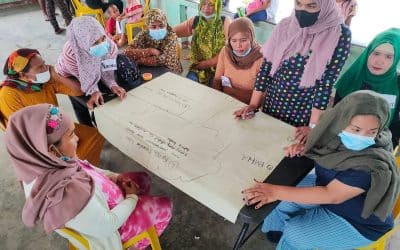InAsia
Insights and Analysis
Myanmar: Resistance and the Cost of the Coup in Chin State
February 7, 2024

A camp for internally displaced persons (IDPs) in Bungkhua Village, Thantlang Township, Chin State. (Photo: Parku)
The first of February marked the third anniversary of the military coup that upended Myanmar’s decade of democracy in 2021 and plunged much of the country into open conflict. Three years later, popular resistance, from peaceful protests to armed insurgency, remains strong, particularly among communities in the country’s border regions, where central control has been contested since Myanmar was a British colony.
Research supported by The Asia Foundation illustrates how Chin State, on the country’s northwestern border with India, is both a center and a broader microcosm of today’s resistance. Home to half a million people, and with historically strong tribal diversity, Chin State has suffered throughout the years of violence and instability that affected much of Myanmar as the country’s military struggled to impose central rule. The result has been persistent underdevelopment, and many people have left Chin State, often as refugees. They now constitute a substantial diaspora regionally and in countries of the Global North.

Townships and border areas of Chin State. (Google Map, Myanmar Township Boundaries MIMU v9.3–MIMUY Geonode [themimu.info])
These armed groups made significant gains in 2023, taking control of resources, territory, roads, and infrastructure in both urban and rural areas. Mirroring the successes of fighters across the country, both the new Chin resistance forces and established armed organizations have pushed back against the military, reportedly capturing 12 military bases and liberating five towns in the last year.
With parts of the country suffering internet blackouts, and information on social media unreliable, it is difficult to grasp a complete picture of the trajectory of the conflict, particularly for observers outside of the country. Airstrikes and arson attacks by Myanmar forces have led to hundreds of deaths and driven tens of thousands of Chin civilians from their homes and livelihoods. The United Nations estimates that more than 60,000 people have fled to the Indian border states of Mizoram and Manipur, while another 61,000 remain internally displaced. Chin humanitarian organizations estimate that the real figures are much higher. Camps for the internally displaced are increasingly insecure as the conflict drags on and resources dwindle, but heavy fighting and the remoteness of the region pose a major challenge for aid and support.
The principal humanitarian response has come from Mizoram, which is estimated to have received more than 5,000 refugees from Chin State in 2023 alone. Refugees in Mizoram have some access to healthcare and children’s education, thanks to a long tradition of cross-border kinship.
As the crisis in Myanmar competes for global attention, international support has diminished. In the meantime, the Chin diaspora, reaching from the border regions of India to communities across Asia, Europe, the United States, Canada, Australia, and New Zealand, has mobilized to provide financial and material aid to refugees and those who remain in Myanmar. Local humanitarian responders estimate that up to 90 percent of the funds they receive come from Chin groups overseas, though this support is often distributed on the basis of local or subethnic ties that can result in unequal access.

Sihmul refugee camp, Mizoram, India. (Photo: JNS)
These developments underscore the central role of Myanmar’s borderlands. Distant from the historical control of the central authorities, these porous, peripheral zones are crucial for the safe passage of refugees, for aid to the internally displaced, and for support of the organized resistance. Border communities in India have set up camps, provided essential services, and even extended financial support to refugees from Chin State. The continued movement of people and goods is critical to maintaining safe havens and humanitarian support for civilians.
Myriad forces are at play today in Myanmar’s resistance. The local roots of the resistance movement have produced a diverse array of actors with different agendas and approaches, and building a united front is challenging. The divergence of approaches and visions among the political leadership and the multitude of armed groups adds a further layer of complexity, as politicians point to their pre-coup electoral mandates, while armed groups cite strong public support. On the ground, communities also hold uncertain views about who is in charge.

IDP camp in Paletwa Town, Chin State, Dec. 2022. (Photo: Chin Human Rights Organization)
Multiple councils and coordinating bodies have emerged from the Chin opposition. Efforts initially focused on the Interim Chin National Consultative Council as a liaison between state actors and the rest of Myanmar’s resistance network, but internal disagreements between a few powerful actors led to a split in early 2023. Subsequently, the rival Chinland Council was created, which has garnered greater support among key resistance forces as well as the public, likely the most crucial factor in its legitimacy as the state’s leading political body. The immediate need is to create a functioning state government and establish statewide systems for public administration and the provision of essential services.
As nonstate forces in Chin State and across Myanmar continue to resist the military’s attempts to impose its central rule, communities caught up in the conflict face severe consequences. International support for civilians is crucial, particularly for the most vulnerable, who have lost homes and livelihoods through violence and displacement. In the immediate term, humanitarian actors can connect with existing local and diaspora networks in the border region to increase the reach and effectiveness of aid distribution. Looking to the future, in Chin State as in other parts of Myanmar, effective investments in peace will hinge on the continuing dialogue between communities and resistance leaders to find common ground for future governance.
Tabea Campbell Pauli is a senior program officer for The Asia Foundation’s Conflict and Fragility Unit. She can be reached at [email protected]. June N.S. is an independent researcher whose latest report, Resistance and the Cost of the Coup in Chin State, Myanmar, is the principal source of this story. The views and opinions expressed here are those of the authors, not those of The Asia Foundation.
About our blog, InAsia
InAsia is posted and distributed every other Wednesday evening, Pacific Time. If you have any questions, please send an email to [email protected].
Contact
For questions about InAsia, or for our cross-post and re-use policy, please send an email to [email protected].The Asia Foundation
465 California St., 9th Floor
San Francisco, CA 94104
The Latest Across Asia
News
April 25, 2024
Program Snapshot
April 18, 2024
News
April 17, 2024

2024 Lotus Leadership Awards
The Lotus Leadership Awards recognize contributions towards gender equality in Asia and the Pacific







0 Comments